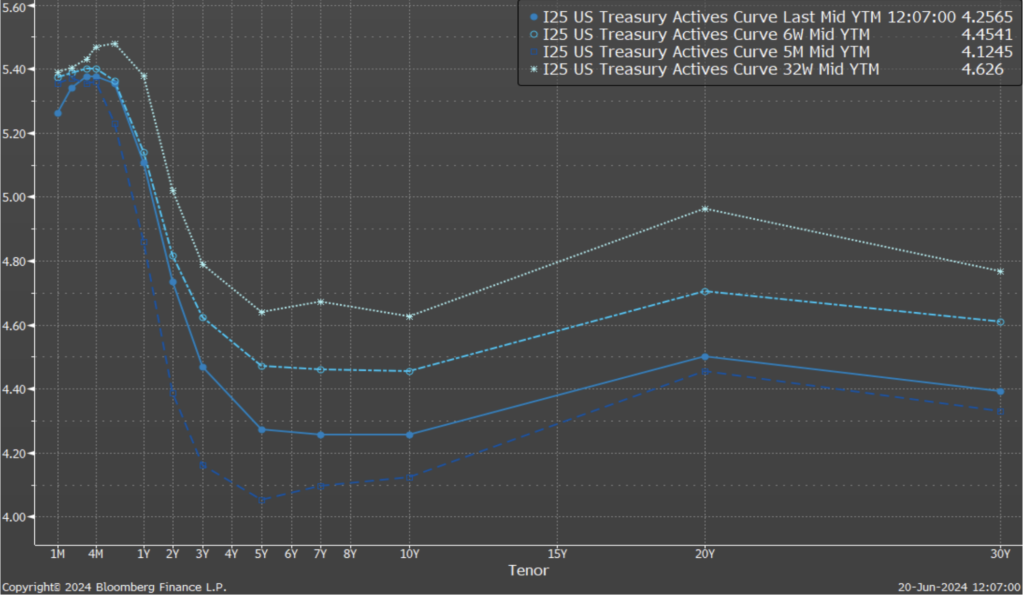Mirador Real Advice Blog
What's Most Important: The Overnight Bank Rate, or The Yield Curve?
August 13, 2024
If you work for the mainstream media, or if their content is all you use, your answer to this question is likely the Bank Rate. If you have a mortgage, a corporate loan, or consumer debt, you are likely more affected by the range of longer term rates that are represented in the yield curve below. So for most of us, if not all of us, the yield curve is most important. Even if you have no debt and think you are insulated from any interest rate changes, the yield curve can give you some clues about the future of the markets and the economy.
In professional level investment management I do sometimes see the yield curve quoted and used, but often the analysts are just using a single data measure such as the difference between 6 month and 10 year yields. This is better than ignoring the yield curve. But remember, a picture is worth a thousand words. An actual, full yield curve is a picture that often is worth thousands of words, thoughts, contemplation, and possible predictions and conclusions.

Many of you are aware of my history and long-standing interest in the bond market. In my presentations I often show a small space between my thumb and forefinger and I say that “if that’s the size of the stock market, the bond market would not likely fit in the room!” The bond market is huge and has been growing rapidly for many years. I believe that its gigantic size and multi-faceted importance attracts a higher level of intellect and acumen than what you typically find in the stock market. And most importantly, the bond market can sometimes hold valuable clues as to the future of the economy and stock indexes.
The yield curve shown is the curve of U.S. Treasury Bonds courtesy of the Bloomberg Professional Terminal Services. I look at other curves, but so many are based on a certain spread to the U.S. curve, so why not focus on the source and leader of the capital markets – the U.S.?
Along the X axis (the bottom axis) are the times to maturity from 1 month out to 30 years. Along the vertical axis at the side are the yields for each term to maturity. The 4 different blue lines are what the yield curve looked like for certain dates in the past, as shown in the upper right legend box (current, 6 weeks ago, 5 months ago, and 32 weeks ago). I selected these time frames because they correspond to major recent inflection points in yields, so they best show how the bond market is reacting to policy management at the central bank.
Typically the yield curve has a positive slope; lower yields for shorter terms to maturity, and higher yields for longer terms. As you can see, the recent curves have mostly a negative slope, which is called an inverted yield curve.
From a very basic level of analysis, the short part of the curve is manipulated by central banks in order to increase or decrease liquidity in the markets which in turn affects economic activity. It also often has a significant affect on a country’s currency because relatively higher short rates attract investment capital, which in turn increase demand for the currency, which may result in higher currency prices.
The short yields have gone from almost zero in 2020 to their current level in the mid 5%s. This tightening of credit availability was done to reduce economic activity in order to get inflation back to the target rate in the mid 2 percent area.
The longer yields represent the summation of a country’s real yield plus an inflation component. The real yield is based on the countries perceived risk – political, fiscal, and monetary. Real yields do not typically change very much or very quickly unless a country is involved in some sort of geopolitical catastrophe like a war or major natural disaster. The inflation component represent bond analysts’ (the smart people) expected inflation in the future, and this can change more frequently and to a greater degree than real yields do.
Inverted yield curves have sometimes signalled coming economic slowdowns or stagnation, which is often accompanied by less bullish stock and commodity price performance. I believe the curve has been telling us this for the last while, and we are recently seeing deterioration in employment and other economic measures and we are seeing improvements in inflation.
The yield curve also needs to be considered when looking at corporations’ earnings. For almost 2 years, cash-rich companies have been able to borrow at low longer yields and invest in higher short yields, adding to their profits without contribution from their core economic business – a sort of false economy.
For the yield curve to lose its inversion and the economy and stocks to become more bullish, most of the slope change needs to come from the short end of the curve. That will be the central banks next challenge – lowering the short yields without causing inflation that raises the longer part of the curve, resulting in a positively sloped, but not too sloped, yield curve. This has started in Canada and a few other countries and fed fund probability curves indicate a good chance of this starting in the U.S. this autumn.
For my own analysis, I do draw straight lines from various short yields to the longer yields for each of the curve dates. This helps me see the slope changes better. It’s a short-hand method – I could export the data and calculate the linear regression of each curve over several terms to maturity, but I am confident the results are similar. And the conclusion is that the curves have started to reduce the inversion and hence better times are around the corner for stocks, bonds, and borrowers.
Stan Clarke
403-608-4664
Investing for Income Believer
